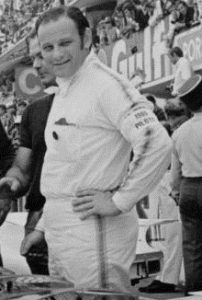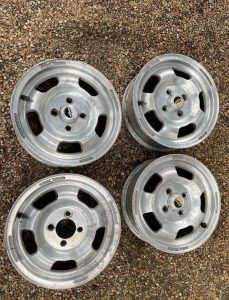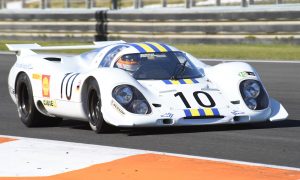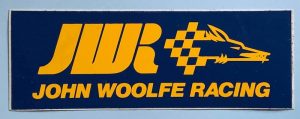EVER WONDERED WHY THE FAMOUS LE MANS RUNNING START WAS CANCELLED FOR THE 1970 RACE? STEVE HOLE BRINGS YOU THE STORY OF JOHN WOOLFE!
John Woolfe was a charismatic successful businessman, gentleman driver and a drag racer. He’d discovered the latter quite late and was a big supporter of the notable drag car builder Mark Stratton’s Hustler operation (‘Lead Sled’ was one of his best-known cars)

A real entrepreneur and enthusiastic racer he also – as a result of getting so heavily into drag racing set up John Woolfe Racing in Bedford, in 1967, which was a shop specialising in all things V8 and all things of a straight line flavour such as Fel-Pro gaskets, Edelbrock and Holley.
His son Tony Woolfe, another enthusiastic racer commissioned GKN subsidiary American Racing Equipment to produce some slot mag-style wheels for him. When Woolfe senior saw them he took them over adding the wheels to his shop inventory.

Jumping ahead slightly – sorry – after his deather, his erstwhile business partner Arnold Burton and American drag racer (based in the UK and acting as manager at John Woolfe drag racing’s shop), David Riswick, bought the rights and moulds from GKN and the launched the Slot Mags range under the new ‘Woolferace’ banner in 1969, shortly after Woolfe’s tragic death at Le Mans.
One day a marvellous chap called Barry Treacy, born in Cork, but living in North London, purchased the Wooferace brand, soon changing the name to the one we all know and love – WOLFRACE.
Anyway, in June 1969, Woolfe was having his second crack at the Le Mans 24 Hours race and even bought the fifth Porsche 917 off the production line for the purpose. Wolfe and his co-driver and friend, Digby Maitland, had retired after about 30 laps with terminal overheating in Wolfe’s Chevron B12. Therefore, Woolfe felt that he didn’t want to risk the B12 again.
Woolfe had a superb racing car collection that also included a Lola T70 Spyder, a Cobra and the well-known ex-John Bekaert Jagust E-type racer.
Porsche was more than slightly concerned that the car, notorious for not having much downforce, but still sold him the car for £16,000. However, they did ‘loan’ him two of their works drivers. Kurt Ahrens to qualify the car (he qualified it ninth) and Le Mans veteran Herbert Linge, who was supposed to be lead driver and take the first stint.
This was after Digby Martland had gone out to practice in the 917 and nearly stuck it into the Armco several times and promptly withdrew. Not content with that Woolfe then blew the engine up. Porsche had a replacement in stock and delivered a replacement to the Le Mans paddock the next morning.
So, following Ahrens’ remarkable effort in qualifying, Porsche tried to persuade Woolfe that Linge should take the first stint. However, because Woolfe had lots of family and friends at the circuit he wanted to take the start and so he refused. Well, it was his car and his team, so what would you have done?
There was a bit of a trend at Le Mans at this time. The famous ‘Le Mans start’ was still in operation but some drivers had taken to doing up their harnesses and belts on the first lap while racing. Willy Mairesse had been seriously injured in 1968 as a result of this and drivers such as Jacky Ickx protested in 1969. Ickx walked leisurely to his car and slowly did up his belts.
When the race started there were 41 drivers running to their cars – and Woolfe, eager to get away didn’t do his belts up. He also proceeded to lose a few places to the. I read somewhere that he looked like he was in a sprint race rather than an endurance event as he tried to carve inside while looking to make up places.

Sadly, his luck ran out as the field approached the notorious White House Bend first time around. Woolfe got two wheels on the grass and the car let go sending it into a vicious spin. The 917’s fuel tank was torn off and hit Chris Amon’s Ferrari setting that alight in a huge fireball. Thankfully, Amon managed to stop and get safely away from his car unscathed.
Meanwhile, the impact as Woolfe’s Porsche hit the bank on the opposite side of the track was sufficient to throw him out of the car. he hadn’t yet done his harnesses up. Tragically, he died in the helicopter on the way to hospital.
As a result, the 1970 edition saw the Le Mans start abandoned and replaced with a conventional standing start. The year after, the organisers moved to a rolling start which is still used to this day.
Woolfe was said to be extremely charismatic and started John Woolfe racing to market American go-faster parts as a result of his newfound love of drag racing. Incidentally, the company still exists and still claims to be the biggest seller in the UK of such parts – visit woolfe.com.
Woolfe wasn’t a professional racing driver but he was a real competitor, first in sprints and hillclimbs before venturing to the race tracks of Europe. Indeed he’d finished first and second at the Brighton Speed Trials in September 1967 in two of cars one of which was an AC Cobra 427 with a Holman Moody 7-litre engine. I think the sister car was a GT40!
As mentioned, Wolfe discovered drag racing. And how. He became a sponsor and supporter of Mark Stratton’s operation and even had Stratton build him his own drag racer. Santa Pod became a popular destination for Woolfe possibly why he opened the John Wolfe Racing operation in 1967.










